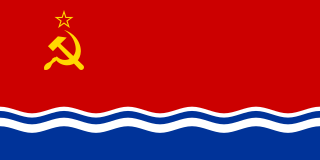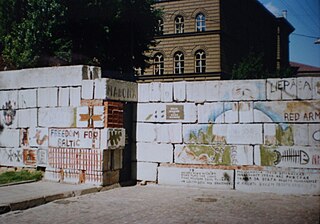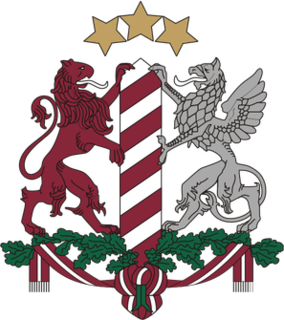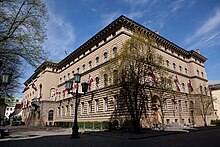
The Singing Revolution is a commonly used name for events that led to the restoration of independence of the Baltic states of Estonia, Latvia, and Lithuania from the Soviet Union at the end of the Cold War. The term was coined by an Estonian activist and artist, Heinz Valk, in an article published a week after 10–11 June 1988, spontaneous mass evening singing demonstrations at the Tallinn Song Festival Grounds. Later, all three countries joined EU and NATO in 2004.

The Latvian Soviet Socialist Republic, also known as Soviet Latvia or Latvia, was a republic of the Soviet Union.

The occupation of the Baltic states involved the military occupation of the three Baltic states—Estonia, Latvia and Lithuania—by the Soviet Union under the auspices of the 1939 Molotov–Ribbentrop Pact in June 1940. They were then annexed into the Soviet Union as constituent republics in August 1940, though most Western powers and nations never recognised their incorporation. On 22 June 1941, Nazi Germany attacked the Soviet Union and within weeks occupied the Baltic territories. In July 1941, the Third Reich incorporated the Baltic territory into its Reichskommissariat Ostland. As a result of the Red Army's Baltic Offensive of 1944, the Soviet Union recaptured most of the Baltic states and trapped the remaining German forces in the Courland pocket until their formal surrender in May 1945.

The prime minister of Latvia is the most powerful member of the Government of Latvia, and presides over the Latvian Cabinet of Ministers. The prime minister is nominated by the president of Latvia, but must be able to obtain the support of a majority of the Saeima (parliament).

The Popular Front of Latvia was a political organisation in Latvia in the late 1980s and early 1990s which led Latvia to its independence from the Soviet Union. It was similar to the Popular Front of Estonia and the Sąjūdis movement in Lithuania.
The modern Latvian independence movement was the resistance movement to foreign occupation of the Republic of Latvia during Soviet and Nazi German occupation (1940–1991).

The Communist Party of Latvia was a political party in Latvia.

The Act of the Re-Establishment of the State of Lithuania or Act of March 11 was an independence declaration by Lithuania adopted on March 11, 1990, signed by all members of the Supreme Council of the Republic of Lithuania led by Sąjūdis. The act emphasized restoration and legal continuity of the interwar-period Lithuania, which was occupied by the Soviet Union and lost independence in June 1940. It was the first Soviet republic to declare independence from the Soviet Union that would cause the dissolution of the Soviet Union in 1991.
The International Front of the Working People of the Latvian SSR or Interfront was a pro-Soviet socialist organization in the Latvian SSR, which during the years 1989–1991, supported Latvia remaining part of the USSR.

The Barricades were a series of confrontations between the Republic of Latvia and the Union of Soviet Socialist Republics in January 1991 which took place mainly in Riga. The events are named for the popular effort of building and protecting barricades from 13 January until about 27 January. Latvia, which had declared restoration of independence from the Soviet Union a year earlier, anticipated that the Soviet Union might attempt to regain control over the country by force.

The Declaration "On the Restoration of Independence of the Republic of Latvia" was adopted on 4 May 1990, by the Supreme Soviet of the Latvian SSR. The Declaration stated that, although Latvia had de facto lost its independence in 1940, when it was annexed by the Soviet Union, the country had de jure remained a sovereign country as the annexation had been unconstitutional and against the will of the Latvian people. Therefore, it resolved that the Molotov–Ribbentrop Pact and the Soviet occupation of Latvia in 1940 were illegal. It also asserted that the heavily rigged 1940 elections were illegal and unconstitutional, and that all acts of the "People's Saeima" chosen at that election–including the request to join the Soviet Union on 21 July 1940–were ipso facto void.

The president of Latvia is head of state and commander-in-chief of the National Armed Forces of the Republic of Latvia.

The State Border Guard is the border guard of Latvia.
The Sovietization of the Baltic states refers to the sovietization of all spheres of life in Estonia, Latvia and Lithuania when they were under control of the Soviet Union. The first period deals with the occupation from June 1940 to July 1941 when the German occupation began. The second period covers 1944 when the Soviet forces pushed the German out, until 1991 when independence was declared.

This Baltic states were under Soviet rule from the end of World War II in 1945, from Sovietization onwards until independence was regained in 1991. The Baltic states were occupied and annexed, becoming the Soviet socialist republics of Estonia, Latvia and Lithuania. After their annexation by Nazi Germany, the USSR reoccupied the Baltic territories in 1944 and maintained control there until the Baltic states regained their independence nearly 50 years later in the aftermath of the Soviet coup of 1991.

The first Godmanis cabinet was the government of Latvia from 7 May 1990 to 3 August 1993. It led Latvia to a restoration of its independence from the Soviet Union and was the first of two governments to be led by Ivars Godmanis, who was also Prime Minister from 2007 to 2009. It took office on 7 May 1990. It was replaced by the Birkavs cabinet on 3 August 1993, after the June 1993 election.

The dissolution of the Soviet Union (1988–1991) was the process of internal disintegration within the Soviet Union, which began with growing unrest in its various constituent republics developing into an incessant political and legislative conflict between the republics and the central government, and ended when the leaders of three primal republics declared it no longer existed, later accompanied by 11 more republics, resulting in President Mikhail Gorbachev having to resign and what was left of the Soviet parliament formally acknowledging what had already taken place.

The House of the Livonian Noble Corporation is a historical building in Riga, Latvia, constructed to house the Landtag of the Livonian Noble Corporation in the Governorate of Livonia. Designed by architects Robert Pflug and Jānis Frīdrihs Baumanis, it was opened in 1867 and housed the Landtag until Latvian independence in 1919, and was subsequently damaged by fire in 1921. Today it is home to the Saeima, the parliament of Latvia. It is located in UNESCO listed Old Riga, directly opposite St. James's Cathedral. The architectural style is neo-Renaissance.
Estonian Restoration of Independence was celebrated on 20 August 1991. As on that day at 23:02 local time, the Estonian Supreme Soviet, in agreement with the Estonian Committee, proclaimed Estonian independence from the Soviet Union. 20 August became a public holiday in Estonia.
The following lists events that happened during 1990 in the Union of Soviet Socialist Republics.















